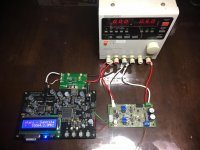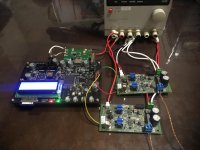GaN Systems is providing an evaluation board for applying GaN E-mode HEMT as a switching device to a class-D audio amplifier.
GS61004B | GaN Systems
https://gansystems.com/wp-content/uploads/2018/01/GS61004B-EVBCD-Rev-171017.pdf
The board assumes a PWM input signal of sampling frequency up to 400 kHz.
Bunpei thought, not only PWM but also PDM, namely delta-sigma modulated 1 bit signal (DSD) might be feasible because a gate driver device, PE29102 is capable up to 40 MHz and GaN E-mode HEMT GS61004B is capable up to 100 MHz.
He told his idea to Professor Yamasaki of Waseda University, who is a leader of 1 bit audio community in Japan. The professor immediately purchased the evaluation board and got a preliminary successful result with TASCAM DA-3000 as a 1 bit signal generator and YAMAHA NS-10M studio monitor as a speaker for 2.8 MHz delta-sigma modulated audio source.
Bunpei got his board today and succeeded in playing 2.8, 5.6, 11.3 MHz sources by using SDTrans384 designed by Chiaki Nakajima as a transport. In his case, not a speaker but a earphone, Etymoic Research ER-4S was used.
Bunpei speculates the experiment by Professor Yamasaki is the first achievement of class-D audio amplifier with direct PDM input.
GS61004B | GaN Systems
https://gansystems.com/wp-content/uploads/2018/01/GS61004B-EVBCD-Rev-171017.pdf
The board assumes a PWM input signal of sampling frequency up to 400 kHz.
Bunpei thought, not only PWM but also PDM, namely delta-sigma modulated 1 bit signal (DSD) might be feasible because a gate driver device, PE29102 is capable up to 40 MHz and GaN E-mode HEMT GS61004B is capable up to 100 MHz.
He told his idea to Professor Yamasaki of Waseda University, who is a leader of 1 bit audio community in Japan. The professor immediately purchased the evaluation board and got a preliminary successful result with TASCAM DA-3000 as a 1 bit signal generator and YAMAHA NS-10M studio monitor as a speaker for 2.8 MHz delta-sigma modulated audio source.
Bunpei got his board today and succeeded in playing 2.8, 5.6, 11.3 MHz sources by using SDTrans384 designed by Chiaki Nakajima as a transport. In his case, not a speaker but a earphone, Etymoic Research ER-4S was used.
Bunpei speculates the experiment by Professor Yamasaki is the first achievement of class-D audio amplifier with direct PDM input.
Attachments
Member
Joined 2006
Hi, CDT!
Thank you very much for your immediate reply!
As for its SQ, I hesitate to show my comment so far because I am listening just a single channel and using commodity level DC power supplies. No modifications are applied to the board. However, it has a good nature worth doing further tunings.
Bunpei
Thank you very much for your immediate reply!
As for its SQ, I hesitate to show my comment so far because I am listening just a single channel and using commodity level DC power supplies. No modifications are applied to the board. However, it has a good nature worth doing further tunings.
Bunpei
There are a number of issues that need to be considered when converting a PDM signal to analog with a power module like this:
Power Supply - an extremely well regulated and decoupled power supply is required to suppress modulation of the supply voltage(s) by the signal that will cause amplitude related distortion
Inter Symbol Interference - unequal rise and fall times or dead times causes the magnitude value of say the positive symbol to not equal that of the negative symbol
Output Filter - complexity will increase as the parasitic elements of the inductor and capacitor in the typical class-D filter will become more significant at higher frequencies
Feedback - cannot be applied to correct any distortions introduced by the above
Switching Losses - will be significantly higher than for class-D thus limiting the available power
Power Supply - an extremely well regulated and decoupled power supply is required to suppress modulation of the supply voltage(s) by the signal that will cause amplitude related distortion
Inter Symbol Interference - unequal rise and fall times or dead times causes the magnitude value of say the positive symbol to not equal that of the negative symbol
Output Filter - complexity will increase as the parasitic elements of the inductor and capacitor in the typical class-D filter will become more significant at higher frequencies
Feedback - cannot be applied to correct any distortions introduced by the above
Switching Losses - will be significantly higher than for class-D thus limiting the available power
A competitive idea?
See: https://datasheets.maximintegrated.com/en/ds/MAX98356.pdf.
There are commercial products available which do similar things conceptually. The maxim chip handle stereo PDM and requires no output filter.Bunpei speculates the experiment by Professor Yamasaki is the first achievement of class-D audio amplifier with direct PDM input.
See: https://datasheets.maximintegrated.com/en/ds/MAX98356.pdf.
To JohnnyInBris
Yes, you are completely right. We may expect a lot of challenges. Among them, the most difficult one must be a power supply as you listed it at the top.
Therefore, I think our goal should not be the high-end audio.
To Tibouchina
Oh, we have not known the MAXIM chip at all. Thank you very much for letting us know it!
When we look at its input and output, it has the same spec as the one we reported in this thread. There might be a different mechanism inside the chip because the diagram of the chip shows a “DAC”.
Yes, you are completely right. We may expect a lot of challenges. Among them, the most difficult one must be a power supply as you listed it at the top.
Therefore, I think our goal should not be the high-end audio.
To Tibouchina
Oh, we have not known the MAXIM chip at all. Thank you very much for letting us know it!
When we look at its input and output, it has the same spec as the one we reported in this thread. There might be a different mechanism inside the chip because the diagram of the chip shows a “DAC”.
Member
Joined 2006
I tried a stereo configuration by using two evaluation boards.
No problems were found.
Direct play of DSD sources sounds very naturally.
Thanks Bunpei, certainly a novel.
"Class D" finally gets interesting.
Any updates regarding SQ or feasability for High End audio?
GaN Systems is providing an evaluation board for applying GaN E-mode HEMT as a switching device to a class-D audio amplifier.
GS61004B | GaN Systems
https://gansystems.com/wp-content/uploads/2018/01/GS61004B-EVBCD-Rev-171017.pdf
The board assumes a PWM input signal of sampling frequency up to 400 kHz.
Bunpei thought, not only PWM but also PDM, namely delta-sigma modulated 1 bit signal (DSD) might be feasible because a gate driver device, PE29102 is capable up to 40 MHz and GaN E-mode HEMT GS61004B is capable up to 100 MHz.
He told his idea to Professor Yamasaki of Waseda University, who is a leader of 1 bit audio community in Japan. The professor immediately purchased the evaluation board and got a preliminary successful result with TASCAM DA-3000 as a 1 bit signal generator and YAMAHA NS-10M studio monitor as a speaker for 2.8 MHz delta-sigma modulated audio source.
Bunpei got his board today and succeeded in playing 2.8, 5.6, 11.3 MHz sources by using SDTrans384 designed by Chiaki Nakajima as a transport. In his case, not a speaker but a earphone, Etymoic Research ER-4S was used.
Bunpei speculates the experiment by Professor Yamasaki is the first achievement of class-D audio amplifier with direct PDM input.
Hello Bunpei,
I guess it is not possible to make volume control in this way. How did you achieve that?
- Status
- This old topic is closed. If you want to reopen this topic, contact a moderator using the "Report Post" button.
- Home
- Amplifiers
- Class D
- Direct PDM input to GaN E-mode HEMT Class-D Amplifier

